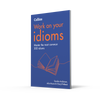Idioms can be a really fun part of language learning with their colourful imagery and quirky cultural connections. However, they can also be a real challenge for learners. There are such a variety of idioms in English and many are impossible to decode on first meeting.
Making mental links
For the new edition of Work on Your Idioms, as with Work on Your Phrasal Verbs that I looked at in my first post, we redesigned the layout of the units to make best use of the space. This included looking carefully at the information we give about each idiom. While a story about the origins of an idiom brought to life by a skilled teacher might help it stick in learners’ minds, research shows that detailed information about etymology presented on the page is less helpful. Learners can find it confusing or distracting or, more often than not, they just ignore it. So, for this edition, we concentrated on what research shows students find most useful*.
In many instances, understanding the literal meaning of an expression helps learners make the mental link to its metaphorical use. For example, knowing that a drawing board is a table where an architect draws the plans for buildings helps learners understand why we say that you go back to the drawing board when a plan has failed and you have to start again. Highlighted boxes throughout the book help students make these links.
Images too can fulfil a similar role, especially, where they illustrate the literal use of the phrase. We’ve included new images in each unit to help illustrate the ideas behind idioms.

Beyond surface meaning: focus on use in context
One big risk with teaching idioms in ELT is that it’s all too easy for learners to simply note down a short but simple definition or translation without taking account of the layers of connotation and cultural references that come along with many idioms. A simple PPP (present, practice, produce) approach to learning idioms risks learners using them in contexts where they don’t fit and may even cause offence, for example, using a light-hearted idiom in a more serious context or something with strong negative connotations directly to someone’s face.
With this in mind, as well as activities to establish the form and basic meaning (denotation) of the target idioms in each unit, we added further practice exercises that focus more on appropriate usage (connotation). For instance, looking at two examples from a matching activity from the unit on the theme of Happiness and Sadness, we can see that it would be inappropriate to match 3 and E. While both idioms describe unhappiness, ‘not a happy bunny’ is too light-hearted to describe a serious situation and is more suited to a minor annoyance, like being woken up early.
We also chose typical contexts in which idioms are used, including conversation and spoken language like the example above, but also journalism. Our research using the Collins COBUILD corpus showed that journalists love to play on idioms in newspaper headlines, so we included activities in which students match idioms in headlines to the first couple of lines of the news stories, for example:

WAKE-UP CALL FOR HEALTH BOSSES
In a survey published this week, 35% of nurses said they were considering leaving the profession …
PLAYERS AND FANS DROPPING LIKE FLIES
As temperatures at yesterday’s Australian Open Tennis tournament hit 35°C, …
These would make for great discussion activities in class with learners explaining the links between the literal and metaphorical meanings of the expressions, why the idioms are appropriate in the context of the news stories, and maybe suggesting images (or finding them online) to illustrate the stories.
To find out more about the new editions of both Work on Your Idioms and Work on Your Phrasal Verbs, browse the full range here.
*Szczepaniak, R. & Lew, R. (2011) The Role of Imagery in Dictionaries of Idioms, Applied Linguistics 32/3
